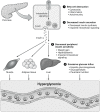Medication-induced hyperglycemia: pediatric perspective
- PMID: 31958298
- PMCID: PMC6954773
- DOI: 10.1136/bmjdrc-2019-000801
Medication-induced hyperglycemia: pediatric perspective
Abstract
Medication-induced hyperglycemia is a frequently encountered clinical problem in children. The intent of this review of medications that cause hyperglycemia and their mechanisms of action is to help guide clinicians in prevention, screening and management of pediatric drug-induced hyperglycemia. We conducted a thorough literature review in PubMed and Cochrane libraries from inception to July 2019. Although many pharmacotherapies that have been associated with hyperglycemia in adults are also used in children, pediatric-specific data on medication-induced hyperglycemia are scarce. The mechanisms of hyperglycemia may involve β cell destruction, decreased insulin secretion and/or sensitivity, and excessive glucose influx. While some medications (eg, glucocorticoids, L-asparaginase, tacrolimus) are markedly associated with high risk of hyperglycemia, the association is less clear in others (eg, clonidine, hormonal contraceptives, amiodarone). In addition to the drug and its dose, patient characteristics, such as obesity or family history of diabetes, affect a child's risk of developing hyperglycemia. Identification of pediatric patients with increased risk of developing hyperglycemia, creating strategies for risk reduction, and treating hyperglycemia in a timely manner may improve patient outcomes.
Keywords: hyperglycemia; medications; pancreatic diabetes; pediatrics.
© Author(s) (or their employer(s)) 2020. Re-use permitted under CC BY-NC. No commercial re-use. See rights and permissions. Published by BMJ.
Conflict of interest statement
Competing interests: None declared.
Figures
References
Publication types
MeSH terms
Substances
LinkOut - more resources
Full Text Sources
Medical

